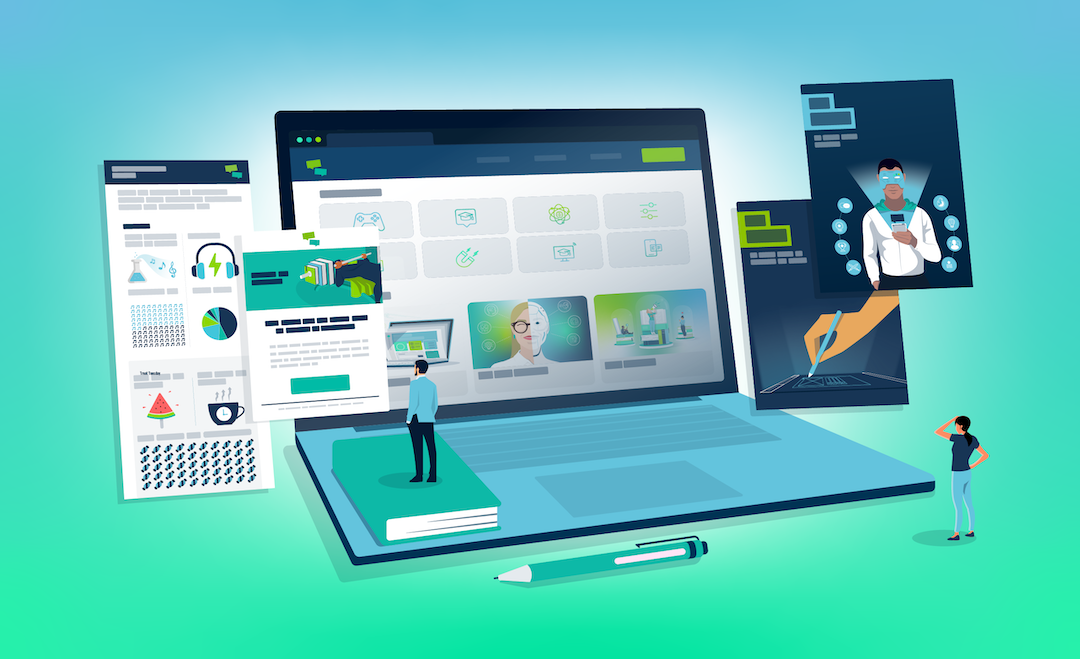For too long, learning and development (L&D) was seen as a ‘nice to have’. But times have changed. Now, a chief learning officer is seen as strategic business partner for growth.
And this makes sense. Chief learning officers can have a big impact on your organisation. Their role is not just about supercharging your employees but reshaping your organisational culture and capabilities as a whole.
Your employee training and development can be the key to keeping your organisation agile and competitive. This is only possible with the right leadership.
Whether you are a chief learning officer, aspire to be one, or wish to hire one to lead your organisation’s L&D department, this article is for you. Our supportive steps will help you to become a successful chief learning officer in no time!
Ready? Let’s go!
What Is a Chief Learning Officer?
A chief learning officer, or CLO, oversees all learning and development programmes within an organisation.
Their primary goal is to ensure that employees have the knowledge and skills needed to be successful in their roles. Chief learning officers do so by creating learning strategies, managing execution and ensuring learning programmes align with overall organisational goals.
Throughout the years, chief learning officers have gone by many names: chief knowledge officer, training director, head of learning and development, chief education officer… The list goes on. This is because the CLO is a relatively new position.
In fact, the term was first introduced in 1994. Since then, both the role and term have grown in importance and popularity. Indeed, AVADO reports that ‘chief learning officer’ is one of the fastest growing titles among the ‘new generation’ C-suite titles, with 900% growth.
Typical Duties
As becomes clear from the definition, chief learning officers have a wide range of responsibilities. These include, for example:
- Creating training programmes and overseeing all L&D efforts
- Evaluating the effectiveness of learning programmes
- Maintaining their organisation’s intellectual capital
- Developing talent and identifying skills gaps
- Creating leaders within the organisation
- Determining budgets and managing all L&D costs
- Serving as a liaison between human resources and other departments
- Crafting, updating or outsourcing training resources
- Evaluating and trialling new training methods and tools
- Creating a long-term training vision for the organisation
The Evolving Importance of CLOs

Chief learning officers can transform more than just your organisation’s learning and development initiatives.
Their strategic role can have a great positive impact on the goals and approach of your organisation as a whole. As such, your CLO plays a proactive role in shaping your entire organisation.
Today’s business environment is more dynamic than ever. As a result, workplace learning has become a key lever for success and competitive advantage. This shift and the increased importance of L&D has influenced the CLO role.
In fact, chief learning officers are no longer responsible simply for training. Instead, they embrace a more powerful role in which they can reshape your business capabilities and organisational culture as a whole.
The more knowledgeable your workers are, the better they can serve your organisation. As such, CLOs perform one of the most important revenue-generating roles in any business. They are serious business operators.
How to Become a Chief Learning Officer
Because the role of the chief learning officer is relatively new, there is no one set path for you to follow. Luckily, there are some steps you can take to help improve your chances.
- Get a bachelor’s degree in education, business, administration, HR or similar field.
- Gain experience as a teacher, trainer or instructor.
- Learn the essential learning models, theories and approaches.
- Work in an administrative or managerial role.
- Gain experience in any kind of corporate officer position, such as CIO, CMO or CCO.
- Consider a master’s degree.
- Seek out professional development opportunities, like educational programmes meant for CLOs.
Skills of a Stellar Chief Learning Officer
Chief learning officers require certain skills to be successful in their roles. Let’s have a look!
1. Strong Interpersonal Skills
As a chief learning officer, you will need a good set of interpersonal skills. After all, you need to be able to communicate with different departments and individuals. You also need to articulate your goals and strategies effectively.
While CLOs routinely work with C-suite and senior-level executives, they are also at the forefront of working with employees of all levels. Interpersonal skills help you get to know and work well with your diverse audiences.
Similarly, as a chief learning officer, you need to be able to sell learning strategies and training initiatives to senior management to secure necessary funding and resources.
Luckily, improving your interpersonal skills allows you to work effectively across all business units. This ensures that all team members are more likely to be on board with change when it comes.
2. Organisational Skills
A successful chief learning officer is a highly organised individual who can manage multiple projects simultaneously.
Organisational skills help you to manage, prioritise and plan everything you need to do. As a result, these skills are essential in optimising your performance.
After all, as a CLO, you need to be able to develop and stick to timelines and budgets. Similarly, you are likely to juggle multiple training projects for different departments at one time.
3. Analytical Skills

The only way to improve your training initiatives is to understand what’s working and what isn’t. With these data points at hand, you can adjust your training programme accordingly.
As such, as a CLO, you need to have an analytical approach to everything you do. This typically requires sufficient knowledge of, for instance, data cleaning, entry, management and interpretation.
After all, trying to craft high-impact training without understanding your data is like baking a cake without using the right measurements. There’s a good chance you’ll end up with a flat cake that won’t rise in the oven and resembles more like a pancake.
Luckily, we have more data around us than ever before, and most digital learning tools come with vast reporting features. This increased availability helps you to drive better learning outcomes.
4. Creativity
In recent years, most businesses have experienced just how quickly their organisational needs might shift. This also includes your learning and development initiatives.
As such, chief learning officers who are flexible and creative will have greater success in the position. They need to be able to adjust to the ever-changing needs of the business, its workforce or both.
Practising the skill of ‘thinking outside the box’ is your sure way to find creative and flexible solutions to whatever challenges your audience or organisation may face.
5. Leadership Skills
As a chief learning officer, you will need to be able to inspire and motivate others to buy into your vision for employee development. As such, you must have experience leading people.
This involves effective problem solving, decision making, delegating and negotiating. Similarly, CLOs need to ensure their audiences understand the link between training, individual effort and the larger organisation-wide strategic vision.
But as most of us have experienced, great leaders are also great listeners. They encourage and motivate their teams and lead by example.
6. Strategic Planning

Strategic planning is an ongoing process that prioritises efforts, allocates resources and aligns the right people to fulfil the right tasks. Ultimately, with strategic planning, organisations can ensure their goals are backed by data and reasoning.
The same principle is important for L&D interventions. You need to ensure your training programme is aligned with your wider organisational objectives.
As such, as a CLO, you need to have a good understanding of strategic planning. This ensures you can create learning programmes that support the needs of your company.
7. Knowledge of Learning Methods and Theories
Chief learning officers typically have access to various resources and tools that make their life easier. But one cannot simply sprinkle game mechanics onto a training course or invest in every fancy social learning app and hope for the best.
It’s essential that CLOs have a good understanding of how corporate learners learn. As such, you need to comprehend both the fascinating field of instructional design as well as the different learning models and concepts that dominate the L&D industry.
Similarly, it’s always a good idea to stay abreast of learning trends, whether that’s a new tool, the latest programme design or an updated learning framework.
8. Emotional Intelligence
Emotional intelligence is essential in all C-level roles. This is your ability to understand and manage your emotions while also influencing others around you.
Daniel Goleman, an American psychologist who helped to popularise the term, highlights five key elements:
- Self-awareness
- Self-regulation
- Motivation
- Empathy
- Social skills
Recognising and managing all five components to a high level will help you to succeed as a CLO. After all, this is a role where you influence people around you. And we are all more motivated by a leader that calmly assesses a stressful situation than one who shouts at their team when under stress.
12 Steps to Succeed as a Chief Learning Officer
1. Create a Mission Statement and Roadmap for Learning
To get buy-in for your learning programme, you need to start by creating a mission statement that aligns with your organisation’s corporate strategy. As such, it needs to reflect your larger organisational goals.
Once you have outlined your mission statement, you need to create your strategic framework or roadmap. This helps you to show what your learning programme prioritises and which projects you’ll undertake, and when.
In addition to your stakeholders, it’s essential that your learners know your mission. It helps to give employee training a purpose. Each learner can see how their training content benefits both their personal goals and the company as a whole.
2. Define Your CLO Governance Model
As a CLO, you need to establish a solid governance model for overseeing and supporting the position. After all, it’s the only way to ensure you have access to the right people and resources to deliver training that has a positive impact on your organisation.
Your governance model guides and helps you to, for instance:
- Evaluate and validate decisions about your L&D budget
- Keep your previously defined roadmap up to date
- Ensure that your learning strategy is aligned with your organisational objectives
- Monitor project completion
- Create advocates for L&D inside your organisation

3. Rethink and Balance Your Learning Methods
Traditional face-to-face learning has been the norm in corporate training for years. However, online learning has slowly and surely started to dominate the arena as technology has advanced to cater for effective eLearning experiences.
The most successful chief learning officers research and experiment to get their balance right. Face-to-face training might be suitable for some and online learning for others. Meanwhile, some organisations prefer blended learning.
All learning methods have their advantages and disadvantages, ones that you need to evaluate based on your audience and their training needs. Top CLOs won’t get stuck in their ways. They’ll take advantage of different methods based on their requirements.
4. Implement the Right Tools
After determining the right learning approach for your audience, your success as a CLO hinges on implementing the best-suited tools and processes. This can include, for instance, people, infrastructure, tools and training content.
Today, digital tools are very popular. After all, technology allows you to take your training programme to another level. It helps you to streamline and scale learning faster than ever before.
Regardless of the tool, you need to ensure it has the intended impact on your training programme. As such, you should test and evaluate your tools regularly and only keep those that have a real impact.
5. Optimise Your Learning Resources Inventory
Identifying the most useful external learning content to support your internal content efforts is one of the key roles of a successful CLO. You need to ensure you have vast resources available for learners with unique learning needs.

But while a library brimming with training resources may sound impressive, it’s often far from it. There’s a lot of uninspired and ineffective training content out there.
As such, chief learning officers need to be selective about the materials they stock, how they structure their content and where they supply it from in the first place.
Similarly, you cannot source your library and forget about it once you have a healthy selection. After all, industries, technologies and research change and evolve day by day. You should conduct a regular content audit to keep things fresh and relevant.
6. Cultivate a Growth Mindset
Learning and development is unnecessary unless your learners are motivated to learn and grow. As such, a great CLO needs to keep their learners’ engagement and energy levels high.
One way to foster a growth mindset is to give your learners more autonomy. In practice, this could mean allowing them to set their own goals and agendas for gaining knowledge and skills important to their unique needs.
This, however, requires a learning environment that sparks your audience into action. Luckily, you can use approaches like gamification to cultivate curiosity and encourage them to learn.
7. Go Beyond Instruction
Instruction alone is rarely enough to create meaningful learning experiences. As such, the most successful CLOs go beyond instruction to provide opportunities for reflection and immersion.
Once your learners have explored new training content, they need to engage in application, analysis or evaluation. This could involve, for instance, group discussions, individual practice or 1:1 sessions where employees can mull over what they have learned and ask further questions.
Afterwards, it’s essential that you allow your learners to put their new skills or knowledge into practice. After all, applying real-life context helps the knowledge to stick.
8. Have a Future-Outlook
Identifying skills your employees are currently missing and tackling those skills shortages is, of course, an effective way to improve their performance. But what’s even more effective is to focus on the future.
By concentrating on capabilities instead of competence, you can ensure you are future-proofing your training programme. It helps you to ensure your employees will perform well in tasks that may not even be defined yet.
As such, successful CLOs focus less on teaching currently needed skills and more on developing behaviours that will benefit the individual and organisation in the long run.
9. Foster Social Learning
Social learning is an extremely effective way to broaden your learners’ knowledge. After all, as the 70:20:10 model highlights, 20% of all learning happens socially through peers, family and friends.
But peer-to-peer learning can arise anywhere within your organisation, which makes it more difficult to capture and analyse. The most successful chief learning officers pay attention to this and support social learning activities throughout the organisation.
They also use digital tools to track activity and safeguard intellectual capital.
10. Be Budget Conscious

Every organisation wants to ensure that every pound they spend is well invested. And unfortunately, L&D budgets are typically the first to be cut if the company experiences tough economic times.
Historically, there has been a lacking understanding of the true impact employee training can bring to an organisation. But as we know now, L&D is more important than ever.
As such, as a CLO, you need to be effective in budget management. This will ensure your stakeholders can trust you will spend your training budget in a way that benefits the organisation the most.
11. Focus on Your Company Culture
A high-performance learning culture is the ultimate goal of every L&D professional. But creating one is not easy.
As such, the top chief learning officers focus on creating an impactful continuous learning culture that engages employees, improves performance and prepares the company for any future challenges.
After all, this kind of culture comes loaded with engaging features and spaced repetition that make learning fun yet effective. As a result, you can wave goodbye to the dreaded Forgetting Curve.
12. Measure Impact
Determining the impact of your training programme can be difficult, but it’s necessary. You won’t know if your learning initiatives are working if you have no means to measure and evaluate what’s changed.
As a CLO, you should record and analyse changes in performance, engagement or learner progression and satisfaction.
Most of today’s modern tools, like LMSs or learning apps, come with a robust reporting suite that gets you off to a great start. But a great CLO knows the most useful metrics to use.
The key is to place the biggest focus on measures that help you to identify how well your learning programme contributes to your organisation’s overall success and strategy. This should form a part of your mission statement, framework and roadmap that you outlined in step one.
Final Words
A career as a chief learning officer can be extremely rewarding. You’ll see your employees take their skills to the next level, and you can shape the future of your organisation. You have the power to make a true impact.
This power comes with responsibility. Luckily, by honing your skills and following our 12 steps, you can supercharge your success as a CLO. Similarly, you can ensure your L&D practices are top-notch!
Instructional design is an essential part of your role as a chief learning officer. Our guide, ‘The Ultimate eLearning Instructional Design Guidebook’, will help you to transform your training programme!








